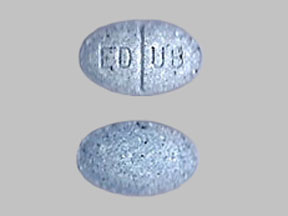Urogesic-Blue
Generic name: hyoscyamine, methenamine, methylene blue, and sodium biphosphate [ HYE-oh-SYE-a-meen, meth-EN-a-meen, METH-il-een-BLUE, SOE-dee-um-bye-FOS-fate ]
Brand names: Urogesic-Blue, UTA
Drug class: Urinary antispasmodics
What is Urogesic-Blue?
Hyoscyamine produces many effects in the body, including relief from muscle spasms.
Methenamine and methylene blue work as mild antiseptics that fight bacteria in the urine and bladder.
Sodium biphosphate is a form of phosphorus, which is a naturally occurring substance that is important in every cell in the body.
Urogesic-Blue is a combination medicine used to treat bladder irritation (pain, burning, inflammation) caused by urinary tract infection. Urogesic-Blue is also used to prevent bladder discomfort during a medical procedure.
Urogesic-Blue may also be used for purposes not listed in this medication guide.
Urogesic-Blue side effects
Methylene blue will most likely cause your urine or stools to appear blue or green in color. This is a normal side effect of the medication and will not cause any harm.
Get emergency medical help if you have any of these signs of an allergic reaction: hives; difficult breathing; swelling of your face, lips, tongue, or throat.
This medicine may cause serious side effects. Stop using this medicine and call your doctor at once if you have:
-
severe dizziness, blurred vision, fast heart rate;
-
agitation, confusion, feeling restless or excited;
-
painful or difficult urination; or
Older adults may be more likely to have side effects from this medication.
Common side effects of Urogesic-Blue may include:
-
mild dizziness;
-
dry mouth; or
-
nausea, vomiting.
This is not a complete list of side effects and others may occur. Call your doctor for medical advice about side effects. You may report side effects to FDA at 1-800-FDA-1088.
Related/similar drugs
Warnings
If you have an eye exam and your pupils are dilated with eye drops, tell the eye doctor ahead of time that you are using Urogesic-Blue.
Before taking this medicine
You should not use this medicine if you are allergic to hyoscyamine, methenamine, methylene blue, or sodium biphosphate.
To make sure this medicine is safe for you, tell your doctor if you have:
-
heart disease;
-
a heart rhythm disorder;
-
congestive heart failure;
-
a heart valve disorder;
-
glaucoma;
-
an enlarged prostate or bladder obstruction;
-
an ulcer or obstruction in your stomach; or
-
if you are allergic to belladonna (Donnatal and others).
It is not known whether this medication will harm an unborn baby. Tell your doctor if you are pregnant or plan to become pregnant while using this medicine.
This medicine can pass into breast milk and may harm a nursing baby. Tell your doctor if you are breast-feeding a baby.
This medicine should not be given to a child younger than 7 years old.
How should I take Urogesic-Blue?
Follow all directions on your prescription label. Do not take this medicine in larger or smaller amounts or for longer than recommended.
Do not crush, chew, or break an enteric coated pill. Swallow it whole. The pill has a special coating to protect your stomach. Breaking the pill will damage this coating.
Drink plenty of liquids while you are taking this medication.
If you have an eye exam and your pupils are dilated with eye drops, tell the eye doctor ahead of time that you are using Urogesic-Blue.
Store at room temperature away from moisture and heat. Keep the bottle tightly closed when not in use.
What happens if I miss a dose?
Take the missed dose as soon as you remember. Skip the missed dose if it is almost time for your next scheduled dose. Do not take extra medicine to make up the missed dose.
What happens if I overdose?
Seek emergency medical attention or call the Poison Help line at 1-800-222-1222.
What should I avoid while taking Urogesic-Blue?
Avoid taking an antacid or anti-diarrhea medicine within 1 hour before or after you take Urogesic-Blue. Antacids or anti-diarrhea medicine can make it harder for your body to absorb hyoscyamine.
If you also take ketoconazole (Nizoral), wait at least 2 hours after taking it before you take Urogesic-Blue.
What other drugs will affect hyoscyamine, methenamine, methylene blue, and sodium biphosphate?
Many drugs can interact with Urogesic-Blue. Not all possible interactions are listed here. Also, hyoscyamine can make it harder for your body to absorb other medications you take by mouth. Tell your doctor about all your medications and any you start or stop using, especially:
-
neostigmine or pyridostigmine;
-
bladder or urinary medicines such as darifenacin, fesoterodine, oxybutynin, tolterodine, solifenacin;
-
bronchodilators such as ipratropium or tiotropium;
-
cold or allergy medicine that contains an antihistamine;
-
a diuretic or "water pill";
-
an MAO inhibitor--furazolidone, isocarboxazid, linezolid, phenelzine, rasagiline, selegiline, tranylcypromine;
-
medication to treat excess stomach acid, stomach ulcer, motion sickness, or irritable bowel syndrome;
-
medication to treat gout, kidney stones, or an electrolyte imbalance (such as low levels of potassium);
-
medication to treat symptoms of Alzheimer's disease or Parkinson's disease;
-
narcotic pain or cough medication--codeine, fentanyl, hydrocodone, hydromorphone, methadone, morphine, oxycodone, propoxyphene, and others; or
-
sulfa drugs.
This list is not complete and many other drugs can interact with Urogesic-Blue. This includes prescription and over-the-counter medicines, vitamins, and herbal products. Give a list of all your medicines to any healthcare provider who treats you.
More about Urogesic Blue (hyoscyamine / methenamine / methylene blue / sodium biphosphate)
- Check interactions
- Compare alternatives
- Pricing & coupons
- Reviews (9)
- Drug images
- Side effects
- Dosage information
- Drug class: urinary antispasmodics
- En español
Patient resources
Other brands
Professional resources
Other brands
Related treatment guides
Further information
Remember, keep this and all other medicines out of the reach of children, never share your medicines with others, and use this medication only for the indication prescribed.
Always consult your healthcare provider to ensure the information displayed on this page applies to your personal circumstances.
Copyright 1996-2025 Cerner Multum, Inc. Version: 3.01.

